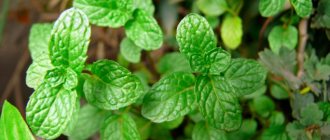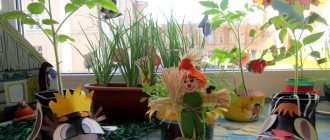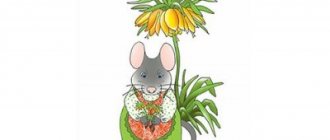Project for children of the preparatory group “Houseplants are our friends”
Elena Astrakhantseva
Project for children of the preparatory group “Houseplants are our friends”
Project for children of the preparatory group
«Houseplants are our friends»
.
Type of project : research, cognitive-creative, short-term (weekly, group .
Project participants : teachers and children of the preparatory group .
Educational areas: communicative, productive and cognitive activities.
Relevance
“To live you need sun, freedom and a little flower”
.
G. – H. Andersen.
Since ancient times, man has sought to decorate his home with plants . Interior landscaping arose as an element of human culture that meets his aesthetic needs. Man felt himself to be one with nature; he turned to it for healing, bringing a piece of living nature into his home. This desire was intuitive. Currently, a scientific approach to interior gardening involves combining the aesthetic perception of the beauty of the form, color of flowers and leaves of plants with another useful function of plants , which has long been known: living plants improve the composition of the air and purify the atmosphere.
Preschoolers spend most of the year in kindergarten, so it is necessary to decorate it with evergreens , which play not only an aesthetic and educational role, but also an educational one. Usually, in any kindergarten, in the corners of nature, there are many different plants brought, depending on their tastes and preferences, by teachers and children, and even parents. Indoor plants create a more comfortable environment, but there is another very important side to their presence - living plants have a beneficial and sometimes even healing effect on our well-being.
Indoor plants bring variety and harmony into our lives. By caring for them, a person is distracted from the bustle of the city, family problems, troubles in everyday life and at work. By observing indoor plants , we learn and grow with them , and we simply relax our souls.
This project involves research work, performing creative and practical tasks, and is aimed at deepening knowledge about indoor plants .
Project “ Indoor plants are our friends ”
children's theoretical knowledge with practical skills acquired during research, develop interest in the world around them and ultimately please their mother with a gift - a flower grown with their own hands.
Goal: to develop interest in the development and growth of indoor plants , observation and curiosity, visual and effective thinking.
Tasks:
1. Contribute to expanding children’s knowledge about indoor plants and their significance in human life.
2. Continue to familiarize children with the structure of the plant , the features and purpose of its parts.
3. Develop practical skills in caring for indoor plants .
4. Develop cognitive interest and research skills (ability to compare, analyze, draw conclusions)
.
5. Expand the ecological environment of the group , unite the efforts of the teacher, children and parents aimed at improving and greening the group .
6. Expand and activate the vocabulary of preschoolers.
children's creative abilities .
8. Develop the mental processes of preschoolers (attention, memory, thinking, imagination)
.
9. Cultivate a caring attitude and love for plants , instill an interest in floriculture.
Expected results:
1. Expanding knowledge on the ecological culture of pupils.
2. Development in children of a sustainable interest in representatives of the plant world - indoor flowers .
3. Development of research activities of preschoolers in the course of joint practical activities with the teacher.
4. Enrichment of children’s vocabulary on this topic
Project implementation :
1. Conversations ( “Useful tips”
,
“
Indoor plants in the interior ” ,
“Getting to know
indoor plants ” ,
“What
indoor plants live in your home ?” ,
“What I remember and liked most”
).
2. Direct educational activities (Cognition. Formation of a holistic picture of the world, broadening one’s horizons: “Journey to the kingdom of indoor plants ”
, Ecology
"
Indoor plants " , Communication
"Flowering
indoor plants " , Communication
"
Indoor plants " , Communication.
Lesson on a series of plot pictures “The Scarlet Flower”
.
3. Reading fiction (Andersen Hans Christian “Thumbelina”
,
“Picky”
Russian folk tale, poems by E. Blaginin
“Balzamin”
, G. Rakov
“Violet”
,
“Aspidistra”
,
“Ficus”
,
“Begonia”
, etc., L. Pilipenko
“Asparagus”
,
“Kalanchoe”
,
“ Aloe”
,
“Saxifrage”
, etc., V. Tushnova
“I don’t understand”
, S. Karatov
“
Indoor flowers ” , N. Nishcheva
“
Indoor flowers ” , O. Alenkina
“Cactus”
, I. Evdokimova
“Cactus”
, Yu. Lysakov
“Cactus”
, B. Ferper
“Begonia”
, B. Pasternak
“Geranium”
, etc.
4. Work in the book corner (subject pictures on the topic, paintings from the series “Care for indoor plants ”
, paintings from the album on speech development
“Children Watering Flowers”
).
5. Search and cognitive activity. (excursion of parents with children to shops - flower department)
6. Experimental activities (studying the structure of a plant leaf under a microscope , cyclic observations: Houseplants decorate our home , Do we need to water the plant ? What kind of water do plants ? Spraying plants , For flowering plants , Examining a new plant , What has changed)
7. Productive activity ( “My favorite flower”
(drawing,
“Geranium”
(applique,
“Calla” (hand labor, from cotton pads and cotton swabs)
.
8. Ecological games ( “If you were an indoor flower ”
).
9. Didactic games ( “Find out the plant ”
,
a plant
by description ” ,
“Where
flowers grow ” ,
“Find the same one”
,
“Find what I’ll tell you about”
,
“Big and small”
,
“Find
a plant ” ,
“Guess what kind of
plant ” ,
“Florist”
,
“Find out
the plant ” ,
“Guess
the plant by description ” ,
“Describe it, and we’ll guess”
,
“Go shopping”
,
“Who needs what”
,
“What’s extra”
,
grows
and how ” ,
“Find
a plant by name ” ,
“Describe the flower”
,
“Riddle, we will guess”
,
“Collect the flower”
,
“What has changed?”
,
“Sell what I name”
,
“Find out
the plant ” ,
“The fourth odd one”
,
“Let’s decorate
the room ” ,
“Collect a bouquet”
,
“Which flower is missing?”
,
“Where is
the plant ?” ).
10. Finger games ( “ Our scarlet flowers ”
,
“There is a prickly flower on the window”
,
“Flower”
).
11. Moving, round dancing games ( “Flowers and the Wind”
,
“
Plants ” ,
“Who can plant flowers faster”
,
“Galya was walking around the garden”
).
12.Board games: “Lay out the flowers”
(mosaic,
“Assemble
a houseplant ” ,
“Assemble a bouquet”
,
“Flower Lotto”
, Domino -
“Flowers”
.
13. Physical education minutes.
14. Morning exercises.
15. Labor activity (watering indoor plants , washing indoor plants , caring for indoor plants : fertilizing, loosening, planting flower seedlings, cutting indoor plants , replanting indoor plants , observing indoor plants in a group , comparing indoor plants .
16. Independent play activities of children . (looking at books, illustrations, albums, postcards with indoor plants , coloring flowers in coloring books, productive activities,
17. Music. P. Tchaikovsky “Waltz of the Flowers”
, excerpt from Concerto for cello e-moll by F. Mendelssohn, musical excerpt from
“Romeo and Juliet”
by S. S. Prokofiev, musical excerpt from Humoresque by A. Dvorak.
18. Watching the cartoon: “Thumbelina”
19.Presentation: “ Indoor plants ”
.
Assessment of the quality of project .
Project “ Indoor plants are our friends ”
involves work with
preparatory group , parents and teachers and is designed for one week.
Analysis of activities will be monitored at the end of the project using observations, interviews with children, teachers and parents. The project implemented through different types of children's activities.
Parents are active helpers in working on the project .
According to parents and teachers, the project “ Indoor plants are our friends ”
interesting and relevant. Thus, we expand the environmental knowledge of preschoolers, form norms of behavior in the natural environment and adherence to them in everyday life, display an active attitude towards natural objects and children acquire practical skills.
Prognostic results.
Children, parents and teachers will have the opportunity to expand knowledge about indoor plants , their significance in human life, develop practical skills in caring for indoor plants and expand the ecological environment of the group .
Dissemination of experience in this area.
The developmental environment in the group .
The relationship between kindergarten and family.






